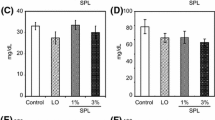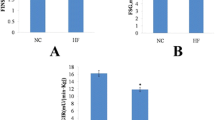Abstract
Phospholipids (PL) containing n-3 polyunsaturated fatty acids (PUFA) have beneficial effects of maintaining and promoting health compared with triacylglycerols (TAG) containing n-3 PUFA or general PL. This study evaluated the effects of dietary PL containing n-3 PUFA and elucidated the effects of the glycerophosphate structure and n-3 PUFA on fatty acid (FA) metabolism in rats. Rats were fed a basal diet containing soybean oil alone, TAG containing n-3 PUFA (1.8 %), soybean PL (2.7 %), PL containing n-3 PUFA (2.7 %), or TAG containing n-3 PUFA (1.8 %) + soybean PL (2.7 %). The present n-3 PUFA-supplemented diets had similar FA compositions, and the PL diets had similar PL compositions. TAG containing n-3 PUFA reduced serum TAG contents, but did not affect serum cholesterol contents compared with soybean oil alone. PL diets containing n-3 PUFA and the combination of TAG containing n-3 PUFA and soybean PL resulted in decreased serum and liver TAG contents compared with the diet containing soybean oil alone, reflecting enhanced liver FA β-oxidation. The results of this study show that TAG containing n-3 PUFA with added soybean PL affects serum and liver TAG and cholesterol contents to a similar degree as PL containing n-3 PUFA. TAG containing n-3 PUFA and soybean PL are widely used as functional food ingredients and pharmaceutical constituents and are inexpensive compared with PL containing n-3 PUFA. Therefore, the combination of TAG containing n-3 PUFA and soybean PL has potential as a useful and inexpensive component of functional foods.


Similar content being viewed by others
Abbreviations
- ACC:
-
Acetyl-CoA carboxylase
- ACOX:
-
Acyl-CoA oxidase
- AIN:
-
American Institute of Nutrition
- ALT:
-
Alanine aminotransferase
- Apo:
-
Apolipoprotein
- AST:
-
Aspartate aminotransferase
- CPT:
-
Carnitine palmitoyl transferase
- DHA:
-
Docosahexaenoic acid (22:6n-3)
- EPA:
-
Eicosapentaenoic acid (20:5n-3)
- FA:
-
Fatty acid(s)
- FAS:
-
Fatty acid synthase
- G6PDH:
-
Glucose-6-phosphate dehydrogenase
- GAPDH:
-
Glyceraldehyde 3-phosphate dehydrogenase
- GC:
-
Gas chromatograph
- HDL:
-
High-density-lipoprotein
- HTGL:
-
Hepatic triglyceride lipase
- LDL:
-
Low-density lipoprotein
- LXR:
-
Liver X receptor
- ME:
-
Malic enzyme
- MUFA:
-
Monounsaturated fatty acid(s)
- PL:
-
Phospholipids
- PPAR:
-
Peroxisome proliferator activated receptor
- PUFA:
-
Polyunsaturated fatty acid(s)
- SCD:
-
Stearoyl-CoA desaturase
- SEM:
-
Standard error of the mean
- SFA:
-
Saturated fatty acid(s)
- SREBP:
-
Sterol regulatory element binding protein
- TAG:
-
Triacylglycerol(s)
- WAT:
-
White adipose tissue
References
Chowdhury R, Stevens S, Gorman D, Pan A, Warnakula S, Chowdhury S, Ward H, Johnson L, Crowe F, Hu FB, Franco OH (2012) Association between fish consumption, long chain omega 3 fatty acids, and risk of cerebrovascular disease: systematic review and meta-analysis. BMJ 345:e6698
Tørris C, Molin M, Cvancarova Småstuen M (2014) Fish consumption and its possible preventive role on the development and prevalence of metabolic syndrome–a systematic review. Diabetol Metab Syndr 6:112
Hedengran A, Szecsi PB, Dyerberg J, Harris WS, Stender S (2015) n-3 PUFA esterified to glycerol or as ethyl esters reduce non-fasting plasma triacylglycerol in subjects with hypertriglyceridemia: a randomized trial. Lipids 50:165–175
Miller PE, Van Elswyk M, Alexander DD (2014) Long-chain omega-3 fatty acids eicosapentaenoic acid and docosahexaenoic acid and blood pressure: a meta-analysis of randomized controlled trials. Am J Hypertens 27:885–896
Phang M, Lincz LF, Garg ML (2013) Eicosapentaenoic and docosahexaenoic acid supplementations reduce platelet aggregation and hemostatic markers differentially in men and women. J Nutr 143:457–463
Robinson LE, Mazurak VC (2013) N-3 polyunsaturated fatty acids: relationship to inflammation in healthy adults and adults exhibiting features of metabolic syndrome. Lipids 48:319–332
Manerba A, Vizzardi E, Metra M, Dei Cas L (2010) n-3 PUFAs and cardiovascular disease prevention. Future Cardiol 6:343–350
Lavie CJ, Milani RV, Mehra MR, Ventura HO (2009) Omega-3 polyunsaturated fatty acids and cardiovascular diseases. J Am Coll Cardiol 54:585–594
Kris-Etherton PM, Harris WS, Appel LJ, Association American Heart, Committee Nutrition (2002) Fish consumption, fish oil, omega-3 fatty acids, and cardiovascular disease. Circulation 106:2747–2757
AMADDEE + COMPANY (2013) Omega-3 marine and plant products: Global markets, competitors and opportunities-2013–2018 analysis and forecasts
Burri L, Hoem N, Banni S, Berge K (2012) Marine omega-3 phospholipids: metabolism and biological activities. Int J Mol Sci 13:15401–15419
Rossmeisl M, Jilkova ZM, Kuda O, Jelenik T, Medrikova D, Stankova B, Kristinsson B, Haraldsson GG, Svensen H, Stoknes I, Sjövall P, Magnusson Y, Balvers MG, Verhoeckx KC, Tvrzicka E, Bryhn M, Kopecky J (2012) Metabolic effects of n-3 PUFA as phospholipids are superior to triglycerides in mice fed a high-fat diet: possible role of endocannabinoids. PLoS One 7:e38834
Awada M, Meynier A, Soulage CO, Hadji L, Géloën A, Viau M, Ribourg L, Benoit B, Debard C, Guichardant M, Lagarde M, Genot C, Michalski MC (2013) n-3 PUFA added to high-fat diets affect differently adiposity and inflammation when carried by phospholipids or triacylglycerols in mice. Nutr Metab (Lond) 10:23
Konagai C, Yanagimoto K, Hayamizu K, Han L, Tsuji T, Koga Y (2013) Effects of krill oil containing n-3 polyunsaturated fatty acids in phospholipid form on human brain function: a randomized controlled trial in healthy elderly volunteers. Clin Interv Aging 8:1247–1257
Hosokawa M, Sato A, Ishigamori H, Kohno H, Tanaka T, Takahashi K (2011) Synergistic effects of highly unsaturated fatty acid-containing phosphatidyl-ethanolamine on differentiation of human leukemia HL-60 cells by dibutyryl cyclic adenosine monophosphate. Jpn J Cancer Res 92:666–672
Hiratsuka S, Ishihara K, Kitagawa T, Wada S, Yokogoshi H (2008) Effect of dietary docosahexaenoic acid connecting phospholipids on the lipid peroxidation of the brain in mice. J Nutr Sci Vitaminol (Tokyo) 54:501–506
Hosomi R, Fukunaga K, Arai H, Kanda S, Nishiyama T, Kanada T, Yoshida M (2010) Effect of phospholipid n-3 polyunsaturated fatty acids on rat lipid metabolism. Eur J Lipid Sci Tech 112:537–544
Hosomi R, Fukunaga K, Fukao M, Yoshida M, Arai H, Kanda S, Nishiyama T, Kanada T (2012) Combination effect of phospholipids and n-3 polyunsaturated fatty acids on rat cholesterol metabolism. Food Sci Biotechnol 21:1335–1342
Hussein G, Nakagawa T, Goto H, Shimada Y, Matsumoto K, Sankawa U, Watanabe H (2007) Astaxanthin ameliorates features of metabolic syndrome in SHR/NDmcr-cp. Life Sci 80:522–529
Reeves PG, Nielsen FH, Fahey GC Jr (1993) AIN-93 purified diets for laboratory rodents: final report of the American Institute of Nutrition ad hoc writing committee on the reformulation of the AIN-76A rodent diet. J Nutr 123:1939–1951
Horton JD, Bashmakov Y, Shimomura I, Shimano H (1998) Regulation of sterol regulatory element binding proteins in livers of fasted and refed mice. Proc Natl Acad Sci USA 95:5987–5992
Prevot AF, Mordret FX (1976) Utilisation des colonnes capillaries de verre pour l’analyse des corps gras par chromotographie en phase gazeuse. Rev Fr Corps Gras 23:409–423
Erdahl WL, Stolyhwo A, Privett OS (1973) Analysis of soybean lecithin by thin layer and analytical liquid chromatography. J Am Oil Chem Soc 50:513–515
Bligh E, Dyer WJ (1959) A rapid method of total lipid extraction and purification. Can J Biochem Physiol 37:911–917
Rouser G, Fkeischer S, Yamamoto A (1970) Two dimensional then layer chromatographic separation of polar lipids and determination of phospholipids by phosphorus analysis of spots. Lipids 5:494–496
Ide T, Watanabe M, Sugano M, Yamamoto I (1987) Activities of liver mitochondrial and peroxisomal fatty acid oxidation enzymes in rats fed trans fat. Lipids 22:6–10
Markwell MA, McGroarty EJ, Bieber LL, Tolbert NE (1973) The subcellular distribution of carnitine acyltransferases in mammalian liver and kidney. A new peroxisomal enzyme. J Biol Chem 248:3426–3432
Tanabe T, Nakanishi S, Hashimoto T, Ogiwara H, Nikawa J, Numa S (1981) Acetyl-CoA carboxylase from rat liver: EC 6.4.1.2 Acetyl-CoA: carbon-dioxide ligase (ADP-forming) In: Lowenstein JM (ed) Methods in Enzymology, Vol. 71. Academic Press, New York
Kelley DS, Nelson GJ, Hunt JE (1986) Effect of prior nutritional status on the activity of lipogenic enzymes in primary monolayer cultures of rat hepatocytes. Biochem J 235:87–90
Hsu RY, Lardy HA (1969) Malic enzyme. In: Lowenstein JM (ed) Methods in Enzymology, vol 13. Academic Press, New York
Kelley DS, Kletzien RF (1984) Ethanol modulation of the hormonal and nutritional regulation of glucose 6-phosphate dehydrogenase activity in primary cultures of rat hepatocytes. Biochem J 217:543–549
Lowry OH, Rosebrough NJ, Farr AL, Randall RJ (1951) Protein measurement with the Folin phenol reagent. J Biol Chem 193:265–275
Lieber CS, Robins SJ, Li J, DeCarli LM, Mak KM, Fasulo JM, Leo MA (1994) Phosphatidylcholine protects against fibrosis and cirrhosis in the baboon. Gastroenterology 106:152–159
Shirouchi B, Nagao K, Inoue N, Ohkubo T, Hibino H, Yanagita T (2007) Effect of dietary omega 3 phosphatidylcholine on obesity-related disorders in obese Otsuka Long-Evans Tokushima fatty rats. J Agric Food Chem 55:7170–7176
Frøyland L, Vaagenes H, Asiedu DK, Garras A, Lie O, Berge RK (1996) Chronic administration of eicosapentaenoic acid and docosahexaenoic acid as ethyl esters reduced plasma cholesterol and changed the fatty acid composition in rat blood and organs. Lipids 31:169–178
Halminski MA, Marsh JB, Harrison EH (1991) Differential effects of fish oil, safflower oil and palm oil on fatty acid oxidation and glycerolipid synthesis in rat liver. J Nutr 121:1554–1561
Voshol PJ, Haemmerle G, Ouwens DM, Zimmermann R, Zechner R, Teusink B, Maassen JA, Havekes LM, Romijn JA (2003) Increased hepatic insulin sensitivity together with decreased hepatic triglyceride stores in hormone-sensitive lipase-deficient mice. Endocrinology 144:3456–3462
Degrace P, Moindrot B, Mohamed I, Gresti J, Du ZY, Chardigny JM, Sébédio JL, Clouet P (2006) Upregulation of liver VLDL receptor and FAT/CD36 expression in LDLR-/- apoB100/100 mice fed trans-10, cis-12 conjugated linoleic acid. J Lipid Res 47:2647–2655
Schuchardt JP, Schneider I, Meyer H, Neubronner J, von Schacky C, Hahn A (2011) Incorporation of EPA and DHA into plasma phospholipids in response to different omega-3 fatty acid formulations–a comparative bioavailability study of fish oil vs. krill oil. Lipids Health Dis 10:145
Acknowledgments
We would like to thank Hiroe Shimizu, Hiromitsu Imaike, and Ryosuke Inayoshi of Kansai University for their help with animal care and lipid analyses. We thank Enago (www.enago.jp) for the English language review.
Author information
Authors and Affiliations
Corresponding author
Ethics declarations
Conflict of interest
The authors declare that there are no conflicts of interest.
About this article
Cite this article
Fukunaga, K., Hosomi, R., Fukao, M. et al. Hypolipidemic Effects of Phospholipids (PL) Containing n-3 Polyunsaturated Fatty Acids (PUFA) Are Not Dependent on Esterification of n-3 PUFA to PL. Lipids 51, 279–289 (2016). https://doi.org/10.1007/s11745-016-4118-0
Received:
Accepted:
Published:
Issue Date:
DOI: https://doi.org/10.1007/s11745-016-4118-0




